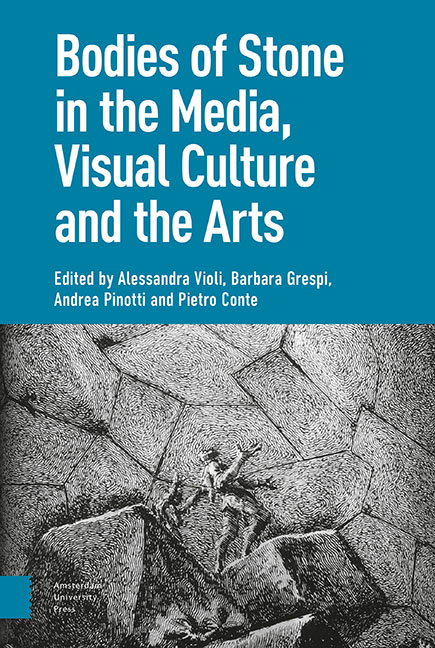Book contents
- Frontmatter
- Contents
- Introduction: Learning from Stone
- I Statue: The Imaginary of Uncertain Petrification
- 1 Theatre and Memory: The Body-as-Statue in Early Modern Culture
- 2 Translated Bodies: A ‘Cartographic’ Approach
- 3 Pantomime in Stone: Performance of the Pose and Animal Camouflage
- 4 Animated Statues and Petrified Bodies: A Journey Inside Fantasy Cinema
- 5 The Ephemeral Cathedral: Bodies of Stone and Configurations of Film
- II Matter: Size, Hardness, Duration
- 1 Bodies That Matter: Miniaturisation and the Origin(s) of ‘Art’
- 2 Brancusi’s ‘Sculpture for the Blind’
- 3 Cinema, Phenomenology and Hyperrealism
- 4 Ephemeral Bodies: The ‘Candles’ of Urs Fischer
- 5 The Celluloid and the Death Mask: Bazin’s and Eisenstein’s Image Anthropology
- III Corpse: Fossils, Auto-Icons, Revenants
- 1 Funeral Eulogy: Post-Mortem Figures and Redeemed Bodies, in Images
- 2 On Jack Torrance As a Fossil Form
- 3 Technical Images and the Transformation of Matter in Eighteenth-Century Tuscany
- 4 Glass, Mixed Media, Stone: The Bodily Stuffs of Suspended Animation
- 5 Bodies’ Strange Stories: Les Revenants and The Leftovers
- IV Monument: Embodying and Grafting
- 1 The Impassibly Fleshly, the Statue of the Impossible
- 2 Frozen into Allegory: Cleopatra’s Cultural Survival
- 3 The Orphan Image
- 4 The Well-Tempered Memorial: Abstraction, Anthropomorphism, Embodiment
- 5 Monuments of the Heart: Living Tombs and Organic Memories in Contemporary Culture
- Index
5 - Bodies’ Strange Stories: Les Revenants and The Leftovers
Published online by Cambridge University Press: 20 November 2020
- Frontmatter
- Contents
- Introduction: Learning from Stone
- I Statue: The Imaginary of Uncertain Petrification
- 1 Theatre and Memory: The Body-as-Statue in Early Modern Culture
- 2 Translated Bodies: A ‘Cartographic’ Approach
- 3 Pantomime in Stone: Performance of the Pose and Animal Camouflage
- 4 Animated Statues and Petrified Bodies: A Journey Inside Fantasy Cinema
- 5 The Ephemeral Cathedral: Bodies of Stone and Configurations of Film
- II Matter: Size, Hardness, Duration
- 1 Bodies That Matter: Miniaturisation and the Origin(s) of ‘Art’
- 2 Brancusi’s ‘Sculpture for the Blind’
- 3 Cinema, Phenomenology and Hyperrealism
- 4 Ephemeral Bodies: The ‘Candles’ of Urs Fischer
- 5 The Celluloid and the Death Mask: Bazin’s and Eisenstein’s Image Anthropology
- III Corpse: Fossils, Auto-Icons, Revenants
- 1 Funeral Eulogy: Post-Mortem Figures and Redeemed Bodies, in Images
- 2 On Jack Torrance As a Fossil Form
- 3 Technical Images and the Transformation of Matter in Eighteenth-Century Tuscany
- 4 Glass, Mixed Media, Stone: The Bodily Stuffs of Suspended Animation
- 5 Bodies’ Strange Stories: Les Revenants and The Leftovers
- IV Monument: Embodying and Grafting
- 1 The Impassibly Fleshly, the Statue of the Impossible
- 2 Frozen into Allegory: Cleopatra’s Cultural Survival
- 3 The Orphan Image
- 4 The Well-Tempered Memorial: Abstraction, Anthropomorphism, Embodiment
- 5 Monuments of the Heart: Living Tombs and Organic Memories in Contemporary Culture
- Index
Summary
Abstract
Focusing on two TV series, the French Les Revenantsand the American The Leftovers, the essay aims to analyse the cultural and techno-scientific paradigm of animation of the inanimate and its opposite, which may range from reification and ghostly disembodiment to a redefinition of what the human is. Driven by an apocalyptic imaginary, both television projects revolve around the failure of the natural order to distinguish and separate life from death; therefore, they revolve as well around the crisis of the psychological, social and ritual processes through which life, by working through the thought of death, allows the subject to make sense of time and reality—that is, to perceive and understand the finitude of things and the mortality of bodies.
Keywords: Body; presence; object; statue; The Leftovers; Les Revenants
While the philosophy of the new millennium has been marked by a shift towards ‘New Realism’, another paradigm has been gradually emerging since the late 1990s, which we may call the ‘paradigm of presence’. Despite the obvious differences between their methods and goals, both paradigms respond to the same desire to promote a description of reality and subjectivity which, unlike postmodern constructivist philosophies, tries to account for the ‘materiality’ of existence, the ‘things of the world’ and human action. At the same time, these paradigms fruitfully respond to the need to acknowledge and reassign value to the ‘work’ of the senses. As Frank Ankersmit puts it, they form part of a more general movement ‘away from language toward experience’, especially as far as the interpretation and the configuration of history are concerned. In Maurizio Ferraris’ view, the movement's main objective is to overturn constructivist hierarchies in the relationship between things and meanings: ‘The organization is first in the world, then in the eye, and only as a last resort in the brain.’ The trend is further confirmed by an emerging interest, in philosophy as well as in the cognitive sciences, in the role of perception and the ‘reasons’ of the body, with a view to reconnecting the action of thought to that of the senses.
Against this background we may also historically account for the renewed attention to the processes by which ‘vital’ qualities are attributed to images, a subject long regarded as a province of the anthropology of art which has now expanded into a study of the nonaesthetic, ongoing relationships between human subjects and images experienced in terms of living presence.
- Type
- Chapter
- Information
- Bodies of Stone in the Media, Visual Culture and the Arts , pp. 277 - 288Publisher: Amsterdam University PressPrint publication year: 2020

